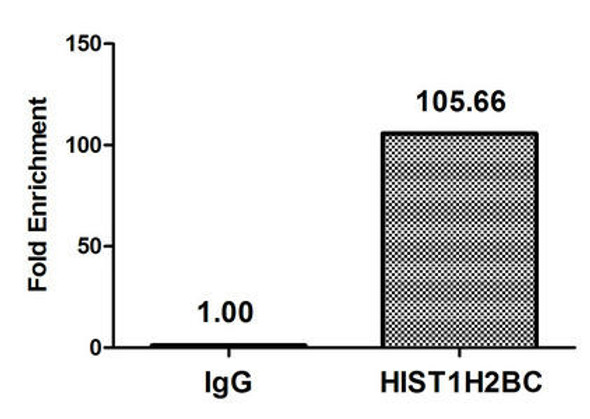Description
Glutaryl-HIST1H2BC (K5) Antibody (PACO60584)
The Glutaryl Hist1H2bc K5 Polyclonal Antibody (PACO60584) is a highly specific and sensitive tool for researchers studying histone modifications and their impact on gene regulation. This antibody, produced in rabbits, is validated for use in various applications, including Western blotting and immunofluorescence.Histone modifications, such as glutarylation of histone H2bc at lysine 5, play a crucial role in regulating gene expression and chromatin structure. By targeting this specific modification, researchers can uncover novel insights into epigenetic regulation and its implications in various biological processes, including development, cancer, and aging.
The Glutaryl Hist1H2bc K5 Polyclonal Antibody offers a unique opportunity to investigate the dynamic changes in histone modifications and their functional consequences. Its high specificity and sensitivity make it an essential tool for scientists aiming to unravel the complex mechanisms underlying gene regulation and cellular function.
| Antibody Name: | Glutaryl-HIST1H2BC (K5) Antibody (PACO60584) |
| Antibody SKU: | PACO60584 |
| Size: | 50ul |
| Host Species: | Rabbit |
| Tested Applications: | ELISA, WB |
| Recommended Dilutions: | ELISA:1:2000-1:10000, WB:1:100-1:1000 |
| Species Reactivity: | Human |
| Immunogen: | Peptide sequence around site of Glutaryl-Lys (5) derived from Human Histone H2B type 1-C/E/F/G/I |
| Form: | Liquid |
| Storage Buffer: | Preservative: 0.03% Proclin 300 Constituents: 50% Glycerol, 0.01M PBS, pH 7.4 |
| Purification Method: | Antigen Affinity Purified |
| Clonality: | Polyclonal |
| Isotype: | IgG |
| Conjugate: | Non-conjugated |
 | Western Blot. Positive WB detected in: Hela whole cell lysate, 293 whole cell lysate (all treated with 30mM sodium butyrate for 4h). All lanes: HIST1H2BC antibody at 1.7µg/ml. Secondary. Goat polyclonal to rabbit IgG at 1/50000 dilution. Predicted band size: 14 kDa. Observed band size: 14 kDa. |
| Background: | Core component of nucleosome. Nucleosomes wrap and compact DNA into chromatin, limiting DNA accessibility to the cellular machineries which require DNA as a template. Histones thereby play a central role in transcription regulation, DNA repair, DNA replication and chromosomal stability. DNA accessibility is regulated via a complex set of post-translational modifications of histones, also called histone code, and nucleosome remodeling. |
| Synonyms: | Histone H2B type 1-C/E/F/G/I (Histone H2B.1 A) (Histone H2B.a) (H2B/a) (Histone H2B.g) (H2B/g) (Histone H2B.h) (H2B/h) (Histone H2B.k) (H2B/k) (Histone H2B.l) (H2B/l), HIST1H2BC; HIST1H2BE; HIST1H2BF; HIST1H2BG; HIST1H2BI, H2BFL; H2BFH; H2BFG; H2BFA; H2BFK |
| UniProt Protein Function: | H2B1C: a core component of the nucleoosome. The nucleosome, a basic organizational unit of chromosomal DNA, is octrameric, consisting of two molecules each of histones H2B, H2A, H3, H4. The octamer wraps approximately 147 bp of DNA. Nucleosomes wrap and compact DNA into chromatin, limiting DNA accessibility to the cellular machineries which require DNA as a template. Histones thereby play a central role in transcription regulation, DNA repair, DNA replication and chromosomal stability. DNA accessibility is regulated via a complex set of post-translational modifications of histones, also called histone code, and nucleosome remodeling. |
| UniProt Protein Details: | Protein type:DNA-binding Chromosomal Location of Human Ortholog: 6p22.1 Cellular Component: cytoplasm; extracellular space; nucleoplasm; nucleus Molecular Function:DNA binding; protein binding Biological Process: antibacterial humoral response; defense response to Gram-positive bacterium; innate immune response in mucosa; nucleosome assembly |
| NCBI Summary: | Histones are basic nuclear proteins that are responsible for the nucleosome structure of the chromosomal fiber in eukaryotes. Nucleosomes consist of approximately 146 bp of DNA wrapped around a histone octamer composed of pairs of each of the four core histones (H2A, H2B, H3, and H4). The chromatin fiber is further compacted through the interaction of a linker histone, H1, with the DNA between the nucleosomes to form higher order chromatin structures. The protein has antibacterial and antifungal antimicrobial activity. This gene is intronless and encodes a replication-dependent histone that is a member of the histone H2B family. Transcripts from this gene lack polyA tails; instead, they contain a palindromic termination element. This gene is found in the large histone gene cluster on chromosome 6p22-p21.3. [provided by RefSeq, Aug 2015] |
| UniProt Code: | P62807 |
| NCBI GenInfo Identifier: | 290457686 |
| NCBI Gene ID: | 8339 |
| NCBI Accession: | P62807.4 |
| UniProt Secondary Accession: | P62807,P02278, Q3B872, Q4VB69, Q93078, Q93080, |
| UniProt Related Accession: | P62807 |
| Molecular Weight: | 13,906 Da |
| NCBI Full Name: | Histone H2B type 1-C/E/F/G/I |
| NCBI Synonym Full Names: | histone cluster 1, H2bg |
| NCBI Official Symbol: | HIST1H2BG |
| NCBI Official Synonym Symbols: | H2B/a; H2BFA; H2B.1A; dJ221C16.8 |
| NCBI Protein Information: | histone H2B type 1-C/E/F/G/I |
| UniProt Protein Name: | Histone H2B type 1-C/E/F/G/I |
| UniProt Synonym Protein Names: | Histone H2B.1 A; Histone H2B.a; H2B/a; Histone H2B.g; H2B/g; Histone H2B.h; H2B/h; Histone H2B.k; H2B/k; Histone H2B.l; H2B/l |
| Protein Family: | Histone |
| UniProt Gene Name: | HIST1H2BC |
| UniProt Entry Name: | H2B1C_HUMAN |

















